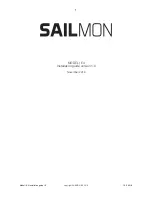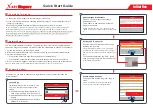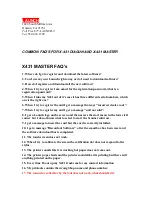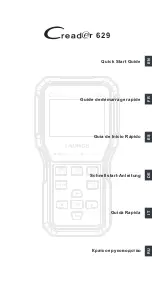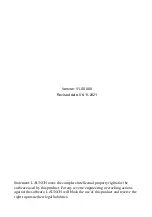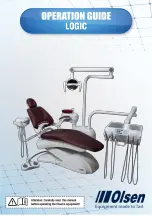
Instruction Sheet
CX Expansion Tanks
402-015
SUPERSEDES: 402-015 dated April 1, 1990
EFFECTIVE: May 1, 2001
Plant ID No. 001-1017
1. Note location on the tank of the system connection, charging valve and
the drain plug. Note labels on the tank or refer to Diagram 1 for location
of tank fittings.
2. Carefully remove the protective cover in the system connection coupling
located at the top center of the tank. There should not be much, if any,
air pressure under this plug.
CAUTION: DO NOT REMOVE THE PIPE PLUGS LOCATED ON THE
SIDE AND BOTTOM OF THE TANK (TANK DRAINS). THESE PLUGS
SHOULD NEVER BE REMOVED UNLESS NECESSARY AND THEN
ONLY AFTER THE AIR PRESSURE IN THE TANK HAS BEEN BLED
OFF TO ZERO GAUGE PRESSURE. BEFORE BLEEDING OFF ANY OF
THE AIR CHARGE, ALWAYS ISOLATE THE TANK FROM THE SYSTEM
WITH A SHUT-OFF VALVE.
3. Before making any connections to the tank, check the tank air charge.
Use an accurate automotive or similar type gauge on the air valve locat-
ed under the tank skirt.
The air charge pressure must be equal to the
pre-charge pressure specified for the system. Refer to the label on
the tank for the specified tank pre-charge pressure. In most cases
the specified tank pre-charge pressure is equal to the system fill
pressure at the tank location.
Use Diagram 2 – Air Charge Check Chart
to correct the value read on the pressure gauge for the ambient temper-
ature at the tank location.
4. After making sure that the air charge is correct, the pipe connection to the
system may now be made. The piping requirements for captive air tanks
are different from those of plain steel expansion tanks. Note the Captive Air
Tank Piping Diagrams. Piping and air elimination devices should be
arranged so that air will not be trapped in the tank, above the tank or in the
nozzle. Pitch the piping connection up away from the tank and use auto-
matic air vents where necessary. Note the piping diagram.
5. Locate the CX tank connection as close as possible to the suction side
of the pump. This ensures that the pressures realized from the pump
head will be additive in the system. A combination shut-off and drain
valve should be located in the connection piping to provide for tank iso-
lation during the initial hydrostatic test.
OPTIONAL
BULLSEYE
SIGHTGLASS
Diagram 1 – Location of Tank Fittings
Diagram 2 – Air Charge Check Chart
How to Use the Chart
1. Determine ambient air temperature where the
tank is being checked.
2. Locate the specified pre-charge pressure in the
left hand column.
3. Follow across horizontally to the number under
the ambient air temperature.
4. The number found under Step No. 3 is the tem-
perature corrected air charge pressure in p.s.i.
and should agree with the gauge reading
observed at the tank.
5. If the temperature corrected air charge pres-
sure differs by more than 1 p.s.i. from the pre-
charge pressure specified for the system, then
correct it by bleeding pressure through the air
charge valve or by adding pressure with an air
compressor.
40.0
70
100
92
84
76
68
60
52
44
36
75.1
73.9
72.6
71.3
70.0
68.7
67.4
66.1
64.9
60
64.5
63.4
62.3
61.1
60.0
58.9
57.7
56.6
55.5
53.9
52.9
52.0
51.0
50.0
49.0
48.0
47.1
46.1
50
43.3
42.5
41.6
40.8
30.0
39.2
38.2
37.5
36.7
40
32.7
32.0
31.4
30.7
29.3
28.6
28.0
27.3
30
22.1
21.6
21.1
20.5
20.0
19.5
18.9
18.4
17.9
20
13.6
13.2
12.8
12.4
12.0
11.6
11.2
10.8
10.4
12
Ambient Temperature (ºF)
Specified
Pre Charge
Pressure
P.S.I.
(at 68ºF)
3
⁄
4
" NPTF
SYSTEM
CONNECTION
CHARGING
VALVE
DO NOT REMOVE.
FACTORY USE ONLY




